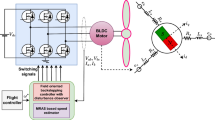Abstract
Brake systems of the future, including BBW (Brake-by-Wire), are in development in various forms. In one of the proposed hydraulic BBW systems, an electric booster system replaces the pneumatic brake booster with an electric motor and a rotational-to-linear motion mechanism. This system is able to provide improved braking performance by the design of controllers with precise target pressure tracking and control robustness for better system reliability. First, a sliding mode controller is designed using the Lyapunov function approach to secure the robustness of the system against both the model uncertainty and the disturbance caused by the master cylinder and mechanical components. Next, a simulation tool is constructed to validate the electric booster system with the proposed controller. Finally, the electric booster system is implemented into an actual brake ECU and installed in a vehicle for testing under various braking conditions. The experimental results demonstrate that the proposed controller produces faster pressure build-up performance than the conventional brake system, and its tracking performance is sufficient to ensure comfortable braking.
Similar content being viewed by others
References
Chang, W., Joo, Y. H., Park, J. B. and Chen, G. (1999). Robust fuzzy-model-based controller for uncertain systems. IEEE Int. Fuzzy Systems Conf. Proc., 1, 486–491.
Hsia, T. C. and Gao, L. S. (1990). Robot manipulator control using decentralized linear time-invariant time-delayed controllers. IEEE Int. Conf. Robot. and Auto., 2070–2075.
Iwasaki, M., Shibata, T. and Matsui, N. (1999). Disturbance observer-based nonlinear friction compensation in table drive system. Mechatronics 4,1, 3–8.
Jeong, H. S. and Lee, C. W. (1997). Time delay control with state feedback for azimuth motion of the frictionless positioning device. IEEE/ASME Trans. Mechatronics 2,3, 161–168.
Kelling, N. A. and Leteinturier, P. (2003). X-by-wire: Opportunities, challenges and trends. SAE Paper No. 2003-01-0113.
Khalil, H. K. (2002). Nonlinear Systems. Prentice-Hall. New Jersey.
Line, C., Manzie, C. and Good, M. C. (2008). Electromechanical brake modeling and control: From PI to MPC. IEEE Trans. Control System Technology 16,3, 446–457.
Line, C., Manzie, C. and Good, M. C. (2004). Control of an electromechanical brake for automotive brake-by-wire systems with and adapted motion control architecture. SAE Paper No. 2004-01-2050.
Ohnishi, K., Shibata, M. and Murakami, T. (1996). Motion control for advanced mechatronics. Mechatronics 1,1, 56–67.
Schenk, D., Wells, R. and Miller, J. (1995). Intelligent braking for current and future vehicles. SAE Paper No. 950762.
Slotine, J. J. E. and Li, W. (1991). Applied Nonlinear Control. Prentice-Hall. New Jersey.
Wang, L. X. (1997). A Course in Fuzzy Systems and Control. Prentice Hall. New Jersey.
Youcef-Toumi, K. and Reddy, S. (1992). Analysis of linear time invariant systems with time delay. ASME J. Dyn. Sys., Meas., and Contr., 114, 544–555.
Author information
Authors and Affiliations
Corresponding author
Rights and permissions
About this article
Cite this article
Yang, I.J., Choi, K. & Huh, K. Development of an electric booster system using sliding mode control for improved braking performance. Int.J Automot. Technol. 13, 1005–1011 (2012). https://doi.org/10.1007/s12239-012-0103-7
Received:
Revised:
Accepted:
Published:
Issue Date:
DOI: https://doi.org/10.1007/s12239-012-0103-7




